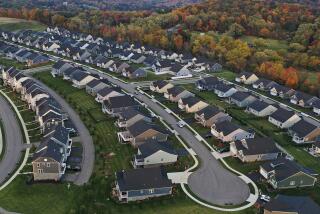This is how California’s governor wants to make it easier to build affordable housing
Reporting from Sacramento — For years, Gov. Jerry Brown has resisted efforts to spend more money to build affordable housing.
As part of his revised budget released Friday, Brown announced what he said was a better solution: making it easier to build homes for low-income residents. In a new package of legislation, Brown is proposing to streamline the permitting process for developers building affordable homes.
“Hopefully, the supply is going to bring down the cost,” Brown said. “Otherwise, through subsidies and through restrictions, we’re just spending more and more tax dollars and getting very, very little.”
Brown’s move nods at the idea, promoted by academics and economists, that the primary issue driving the state’s out-of-control housing costs isn’t a lack of housing subsides, but rather that there’s not enough homes to meet demand.
How much Brown’s proposal will do to boost affordable housing depends on the extent it attempts to override local development restrictions. The plan exempts from detailed local government reviews urban development projects that have at least 20 percent of their units set aside for low-income residents. For developments near transit, the projects only need to have 10 percent of their units designated affordable to qualify.
Brown’s plan requires local governments to already have zoned land for high-density residential projects. For instance, a developer proposing to build 300 condominiums on land now planned for 100 units wouldn’t qualify even if the project included affordable housing because of the existing zoning.
Carol Galante, a professor of affordable housing and urban policy at UC Berkeley, called Brown’s effort “forward-thinking” because it attempts to address bottlenecks in the development process. Its reliance on local governments to have already set aside enough land for residential development could limit its effects, she said.
“Where this is going to help is with those cities who have already given lip service to higher-density zoning, but perhaps don’t really intend to see it through all the way,” Galante said.
Brown is likely to face opposition from local governments on his proposal. The League of California Cities and California State Association of Counties already have lined up against bills pending in the Legislature aimed at increasing housing supply by removing local restrictions.
Local governments do detailed reviews of development projects in response to the public’s demands for them, said Dan Carrigg, the legislative director of the League of California Cities.
“It’s natural that the community would care about parking and traffic because they’re going to have to live with the project for a long time,” Carrigg said.
Brown’s revised budget embraces a plan from Senate Pro Tem Kevin de León (D-Los Angeles) to reallocate money from a tax on wealthy Californians toward building housing for the state’s mentally ill homeless population. But Brown put no money toward a $1.3 billion proposal from Assembly Democrats for tax credits, development subsidies and grants to spur homebuilding for residents with the lowest incomes. A co-author of that measure, Assemblyman David Chiu (D-San Francisco), said he still expects to work with Brown on funding during the revision process before the June 15 deadline.
Follow me at @dillonliam on Twitter
ALSO:
Gov. Jerry Brown sends lawmakers revised California budget with less money to spend on new programs
California doesn’t have enough housing, and lawmakers aren’t doing much about it
Assembly Democrats want more than $1 billion for affordable housing next year
More to Read
Get the L.A. Times Politics newsletter
Deeply reported insights into legislation, politics and policy from Sacramento, Washington and beyond. In your inbox three times per week.
You may occasionally receive promotional content from the Los Angeles Times.








